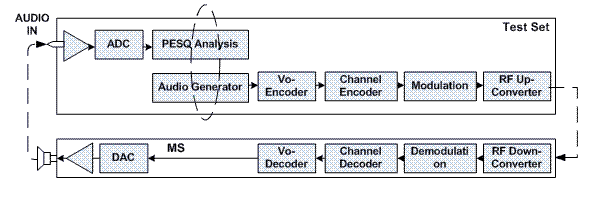Perceptual Evaluation of Speech Quality (PESQ) Measurement Description
Last updated: October 26, 2010
This section is only applicable to the feature-licensed lab application or test application
How is a PESQ measurement made?
Perceptual Evaluation of Speech Quality (PESQ), as defined in the ITU-T P.862 standard, is a objective method to test the speech quality of the mobile station. The objectivity is based on the comparison to the traditional MOS (Mean Opinion Score) method in which a group of listeners are used to rate the voice quality to a value ranging from 1(bad) to 5 (excellent).
When
AMR Voice
is selected as the paging service (see
Paging Service
), the
AMR Source
is set to PESQ and the
AMR Radio Access Bearer
is set to a desired vocoder (see
AMR Setup
), the test set supports the PESQ measurement by comparing the original signal with the received signal passed through a communication system. After the PESQ analysis, a score is given ranging from -0.5 to 4.5. A higher score means a better speech quality.
There are three modes provided for this measurement: Uplink Audio, Downlink Audio and Both.
- Uplink Audio: The test set acts as an audio generator, generates the original signal and sends it to the front-panel AUDIO OUT port which is connected to the mobile station's audio in port. The mobile station encodes the signals into speech frames of the uplink traffic channel. The test set then decodes the received speech frames, compares the original signal with the received signal and makes the PESQ measurement. See Typical Signal Flow with Uplink Audio Mode .
- Downlink Audio: The test set acts as an audio generator, generates the original signal and encodes it into speech frames of the downlink traffic channel. The mobile decodes the received speech frames and outputs it to its audio out port which is connected to test set' s AUDIO IN port. The test set then compares the original signal with the received signal and makes the PESQ measurement. See Typical Signal Flow with Downlink Audio Mode .
- Both: The test set performs the Uplink Audio measurement and Downlink Audio measurement simultaneously.
PESQ Measurement Parameters
The parameters shown in the PESQ Setup menu include:
-
Measurement Mode - specifies the measurement mode to perform the PESQ measurement. When
Uplink Audiois selected, the test set generates the original signal and analyzes the received uplink signal from the mobile to perform the PESQ measurement. WhenDownlink Audiois selected, the test set generates the original signal and analyzes the signal at its AUDIO IN port. If theMeasurement Modeis set to Both, the test set performs the uplink and the downlink PESQ measurement simultaneously.GPIB Command: SETup:WPESquality:MEASurement:MODE
It is suggested to do the uplink and downlink PESQ measurement respectively although the test set supports the "Both" measurement mode. This is because some mobile phones have bad isolation between their audio in and audio out path. If performing the downlink and uplink measurement simultaneously, the uplink measurement will be affected a lot by the Downlink measurement.NOTE
- Speech Source - specifies the speech source for use to perform the PESQ measurement. The test set supports two speech sources in accordance with the ITU-T P.862 standard:
MaleandFemale.GPIB Command: SETup:WPESquality:SPEech
- Expected Audio In Peak Voltage - Specifies the absolute peak voltage of the audio signal expected at the AUDIO IN port of the test set.
GPIB Command: SETup:WPESquality:INPut:VOLTage[:EXPected]
- Maximum Audio Out Peak voltage - Specifies the maximum peak voltage of the audio signal that can be output at the AUDIO OUT port of the test set.
GPIB Command: SETup:WPESquality:OUTPut:VOLTage[:MAXimum]
- Trigger Arm - (see Trigger Arm (Single or Continuous) Description ).
GPIB Command: SETup:WPESquality:CONTinuous
- Measurement Timeout - (see Measurement Timeouts ).
GPIB Command: SETup:WPESquality:TIMeout[:STIMe]
PESQ Measurement Results
- Integrity Indicator - (see Integrity Indicator ).
- Uplink PESQ Score - indicates the uplink PESQ score, with the range from -0.5 to 4.5.
- Downlink PESQ Score - indicates the downlink PESQ score, with the range from -0.5 to 4.5.
- PESQ Uplink Headroom - indicates the signal headroom value before PESQ analysis when doing uplink PESQ measurement. This value can help you to adjust the signal level at the audio in port of the mobile so that the uplink signal level is not too large or too small to affect the PESQ score.
- PESQ Downlink Headroom - indicates the signal headroom value before PESQ analysis when doing downlink PESQ measurement. This value can help you to adjust the downlink signal level so that the signal at the AUDIO IN port of the test set is not too large or too small to affect the PESQ score.
- AMR RAB - indicates the current AMR Radio Access Bearer.
-
PESQ Measurement Status - indicates the whether the PESQ measurement is
In ProgressorCompleted.
Related Topics
GPIB Commands: SETup:WPESquality , FETCh:WPESquality .
Measuring Perceptual Evaluation of Speech Quality (PESQ)
Perceptual Evaluation of Speech Quality Measurement Troubleshooting
- Speech Source - specifies the speech source for use to perform the PESQ measurement. The test set supports two speech sources in accordance with the ITU-T P.862 standard:

